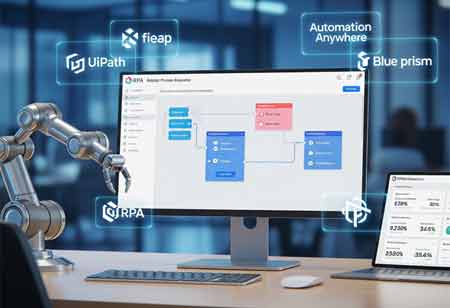THANK YOU FOR SUBSCRIBING

Top E-Commerce Tech Solution Providers 2025

Nominate a Company
Usually, the qualified subscribers of our magazine nominate companies with whom they have collaborated and experienced exceptional results to be in this list. Did a company you recently worked with give you stellar results and ROI? Did it turn out to be one you would wholeheartedly recommend to peers? Or do you know of such an outstanding company through your network? Please fill in the details below and nominate them to be featured here.
*
Thank You!

We are glad to receive your nomination. Our editorial team and evaluation panel will review your submission. Thank you for taking the time to highlight an organization driving impactful change in APAC CIOOutlook.
Data not inserted
OneProof is Japan’s most prominent internet storefront provider, offering comprehensive e-commerce solutions. It helps companies develop an online retail presence and market strategies tailored to the Japanese market. It also develops strategies and marketing plans to facilitate partnerships between foreign companies and Japanese retailers.
AnyMind Group (AnyX) offers a unified e-commerce channel management platform that integrates sales, inventory, CRM, and KPI reporting. It enables brands to streamline operations, enhance customer engagement, and expand sales channels through real-time data synchronization and customizable dashboards.
OnPoint is Vietnam’s leading e-commerce enabler, providing one-stop, data-driven solutions including omni-channel strategy, e-store management, marketing, and logistics. It supports Southeast Asian brands with technology and expertise to accelerate growth and optimize customer engagement across digital commerce.
Shippit is a cloud-based shipping platform that simplifies e-commerce fulfillment by integrating multiple couriers and automating delivery workflows. It helps retailers optimize shipping costs, improve delivery speed, and enhance customer satisfaction through real-time tracking and analytics.
Up2China bridges international brands with Chinese consumers, offering end-to-end e-commerce solutions. It manages platform positioning, D2C infrastructure, social media marketing, and data-driven insights to maximize brand growth and customer retention in China’s dynamic online marketplace.
Top E-Commerce Tech Solution Providers 2025
More in News
Big Data Analytics Enhancing Supply Chain
Friday, October 31, 2025
Big data is creating a substantial impact by changing supply chain management for the better. With vast amounts of available data, it is becoming difficult for organizations to choose the right data for analysis. Organizations are diving deeper into their data sets and coming up with key insights to apply to their operations. Big data analytics is providing supply chain networks with greater data accuracy, clarity, and insights, leading to more contextual intelligence shared across supply chains. Integrating big data and advanced analytics into business processes helps streamline operations. The main benefit of incorporating big data analytics in supply chain management is customer service. By leveraging big data analytics, organizations can get a complete view of what their customers’ requirements are, understand their needs and preferences, and accordingly create a delightful customer experience. Another major benefit is supply chain traceability. Advances in digital technologies enable supply chain companies to precisely track products in their supply chain. Sensors along with IoT enable end-to-end traceability, which helps companies quickly identify the instances of issues. Big data analytics along with machine learning and optimization algorithms help identify patterns and associations between the datasets and assist in deducing strategic and tactical procurement decisions. Predictive analytics help organizations identify future trends and risks including supplier risk, pricing risk, and geographical risk. For organizations that deal with supply chain activities, speed and agility are the key driving factors. Big data also enables supply chain managers to maintain an optimum level of inventory so that they do not face a stock-out situation. While many organizations still haven’t adopted big data, incorporating it will serve as the catalyst that improves efficiency, productivity and gets them moving on their journey. See Also: Top Big Data Solution Companies See Also: Top Data Analytics Companies In Europe
AI for Knowing Customers' Preference in E-Commerce
Thursday, October 30, 2025
There was a time when we used to see AI only in sci-fi movies and books. But, the scenario has changed a lot today. In the last decade or more precisely the past few years, several industries have embraced AI to get to closer to customers than ever before. According to a report from Gartner, 85 percent of customer interactions will be managed without any human intervention by 2020. While many industries have witnessed profound growth owing to the services of AI, e-commerce deserves a special mention because it has created several viable portals through AI to enhance the interaction channels of customers. During purchasing AI can act as a virtual assistant and give customers shopping notifications and personalized recommendations of the best-suited products. With AI machine learning, e-commerce portals can learn and remember customers’ preference so that it can recommend purchase items without doing any manual work. Many e-commerce providers also used chatbots to check the status of any specific order and ask questions if they have any doubt related to that account. Chatbots enables customers to make personalized service they need without waiting for a long time. The bots can scan the online profiles of customers and respond to their queries them in real time. Apart from rendering personalized customer services, bots also bring forth customer intelligence capabilities. If an e-commerce company uses chatbots for scanning customers’ profiles and purchasing history, they get a lot of data to improve their offerings and be competitive in the market. It also helps industries to leap ahead in the market race through keeping a competitive price with market standards. Used in almost every industry today, one can predict that more and more AI be leveraged in the coming years to determine the predictability of customer behavior.
APAC's Transformation Services Powering Economic Reinvention
Wednesday, October 29, 2025
The narrative of economic development in the Asia-Pacific (APAC) region is being fundamentally rewritten. Where gradual, linear progress was once the norm, many of APAC's emerging economies are now engaged in a profound "leapfrogging" moment. They are bypassing entire generations of legacy technology and infrastructure—moving straight from unbanked to digitally banked, from sparse landlines to ubiquitous 5G, and from traditional bazaars to sophisticated social commerce platforms. This non-linear jump is creating a super-heated market for digital transformation services. Unlike in mature economies, where "digital transformation" often means migrating complex, aging systems to the cloud, in emerging APAC, it means building entirely new, cloud-native, and AI-first systems from the ground up. This greenfield opportunity has ignited an unprecedented boom for service providers specializing in everything from cloud architecture and data analytics to artificial intelligence and cybersecurity. The industry is no longer just a supporting player; it is the primary engine of economic and social change. The Foundational Accelerators Nations across Southeast and South Asia are powered by vast, young, and digitally native populations. This is a "mobile-first" generation that did not need to be taught digital; they simply expect it. Their demand for seamless, instant, and personalized services is the primary catalyst driving innovation. This consumer behavior creates a large, receptive market for digital-first business models. The rapid, widespread proliferation of affordable high-speed mobile data has made connectivity a universal utility reaching both urban and rural regions. This connectivity is the soil from which the digital economy grows. It ensures that a farmer in a remote province has access to the same digital payment systems and market information as a merchant in a capital city, creating a truly unified digital marketplace. Proactive governance has also set the stage for this transformation. Governments across the region have moved with conviction, launching ambitious national digital agendas. These initiatives—ranging from digital identity programs and e-governance platforms to incentives for SME digitalization and investment in national data infrastructure—act as a powerful tailwind. By championing digital adoption and investing in foundational frameworks, public sector bodies have become both the key enablers and the largest clients for the digital services industry. The Core Pillars of Service Demand The demand for digital services in today’s evolving landscape is expanding rapidly, converging around three high-growth pillars: cloud infrastructure, artificial intelligence, and cybersecurity. At the foundation lies the cloud-native imperative, where businesses are increasingly “born in the cloud,” eliminating the need for traditional server rooms. This has driven a surge in hyperscale data center construction and a shift toward sophisticated cloud-native development, containerization, and hybrid-cloud orchestration. Scalability, agility, and cost-efficiency are now baseline expectations, pushing service providers to deliver robust and adaptive digital foundations. The intelligence layer, powered by AI and data, represents the region’s opportunity to leapfrog legacy systems. With no entrenched infrastructure to overhaul, businesses are directly embracing advanced AI and machine learning applications to extract value from massive volumes of digital data. This is fueling demand for generative AI in personalized marketing, predictive analytics for supply chain optimization, and AI-driven risk modeling in FinTech, while industrial sectors increasingly turn to “embodied AI” for robotics and smart manufacturing. As entire economies move online, the trust fabric—cybersecurity and governance—has emerged as a critical enabler of digital transformation. The focus has shifted from traditional firewalls to next-generation solutions in identity and access management, cloud security posture management, and real-time threat detection. Concurrently, new government frameworks around AI safety and data sovereignty are driving demand for advisory and compliance services. Together, these pillars form the foundation of a secure, intelligent, and cloud-native digital ecosystem. Sector-Specific Metamorphosis This ongoing wave of transformation across the region is far from uniform—it is driving deep, structural shifts within its most critical economic sectors. In financial services, the rise of FinTech has become synonymous with advancing financial inclusion. Digital wallets and “super-apps” now function as the new bank branches, integrating tens of millions into the formal economy for the first time. This momentum has created fertile ground for growth in digital payment integration, micro-lending platform development, and AI-driven insurtech solutions. In retail and commerce, the leap has been from traditional marketplaces directly to social and live-stream commerce. The “creator economy” has emerged as a powerful engine of growth, supported by an expanding ecosystem of digital transformation services. These include the development of e-commerce platforms, seamless digital payment integrations, and advanced data analytics tools that enable sellers and creators to understand and respond to consumer behavior in real time. The manufacturing and logistics sectors are experiencing their own Industry 4.0 revolution. As the region cements its role as a global manufacturing hub, investments are pouring into the creation of “smart factories.” Key innovations include IoT integration for real-time asset tracking, digital twin simulations to optimize production lines, and AI-powered automation designed to boost efficiency, precision, and overall output quality. The digital transformation services industry in emerging APAC is one of exponential growth and boundless opportunity. This is far more than an IT upgrade cycle; it is a fundamental re-architecting of the region's economic operating system. What makes this moment so unique is that these emerging economies are not following a map—they are drawing it. By building digital-first, AI-native systems from the outset, the region is bypassing decades of technological debt. The digital services industry is the catalyst for this change, and in doing so, it is positioning emerging APAC not just as a consumer of global innovation but as a future-defining source of it.
Data Governance as a Service: The New Mandate for APAC's Compliance Consulting Firms
Tuesday, October 28, 2025
Digitalization across the Asia-Pacific (APAC) region has created a dual reality for businesses: unprecedented opportunity and unparalleled risk. As data becomes the lifeblood of the modern enterprise, its proper management has shifted from an IT-centric task to a core business imperative. Navigating the intricate web of evolving data protection regulations, ensuring data quality, and leveraging data for strategic advantage requires a specialized skill set that many organizations lack internally. This gap has paved the way for a new consulting paradigm: Data Governance as a Service. For compliance consultants in APAC, this represents not just a new service line but a fundamental evolution of their role, positioning them as indispensable partners in the data-driven economy. A Natural Evolution for Compliance Consultants Compliance consultants are uniquely positioned to spearhead the Data Governance as a Service movement. Their profession is built on a deep understanding of regulatory landscapes, risk management, and the implementation of internal controls. The principles that underpin financial, operational, and legal compliance are directly transferable to the realm of data. Consultants already excel at interpreting complex legal texts—like Singapore's Personal Data Protection Act (PDPA), India's Digital Personal Data Protection (DPDP) Act, or Australia's Privacy Act—and translating them into actionable corporate policies. Data Governance as a Service is the logical next step, moving beyond mere advisory to active stewardship. Instead of just writing the rulebook, the consultant now helps officiate the game on an ongoing basis. This evolution leverages their core competencies in policy creation, risk assessment, and auditing, applying them to an organization's most critical 21st-century asset: its data. This transition allows consultants to build deeper, more resilient client relationships, shifting from periodic auditors to embedded strategic partners. Core Components of a Data Governance as a Service Offering A comprehensive Data Governance as a Service offering delivers an end-to-end framework for effective data management, oversight, and compliance. It begins with Policy and Standards Management, where the provider develops and maintains a robust governance framework that defines data privacy policies, usage guidelines, and quality standards aligned with industry-specific regulations. Alongside this, Data Stewardship and Ownership ensure accountability by establishing clear roles for managing data assets, with the Data Governance as a Service provider supporting the identification and training of data stewards within the client organization. Central to the Data Governance as a Service model is Metadata Management, which involves building and maintaining a centralized repository of metadata—encompassing data definitions, business glossaries, and data dictionaries—to create a unified data language across the enterprise. Data Quality Management complements this, a continuous process of monitoring, assessing, and improving data accuracy, completeness, and consistency to ensure reliability and fitness for purpose. Rounding out the service are Data Lineage and Traceability and Compliance Monitoring and Reporting, which provide transparency and regulatory assurance. Data lineage mapping tracks the flow of data from origin to destination, enabling organizations to demonstrate data provenance and assess downstream impacts. Compliance monitoring offers proactive tracking of adherence to policies and regulations, with regular reports and dashboards that give senior management a clear, data-driven view of the organization’s governance posture. The APAC Context The APAC region is a particularly fertile market for Data Governance as a Service. Its economic dynamism is matched by its regulatory diversity. Unlike the more harmonized GDPR framework in Europe, APAC is a patchwork of national laws, each with its own nuances on data sovereignty, cross-border data transfers, and consumer rights. A business operating in Singapore, with customers in Australia and a back office in India, must navigate three distinct and complex legal frameworks. This complexity creates a significant compliance burden that many small and medium-sized enterprises (SMEs) and even some larger corporations are ill-equipped to handle. They lack the in-house legal and technical expertise to stay abreast of legislative changes across multiple jurisdictions. Data Governance as a Service provides a powerful solution that offers access to a shared pool of experts specializing in the APAC regulatory landscape. This allows businesses to focus on their core operations while ensuring their data handling practices remain compliant, secure, and strategically aligned across this diverse and fast-growing economic theater. Data Governance as a Service marks a pivotal shift in the consulting landscape. It moves the discipline from a theoretical exercise to a practical, operational reality. For compliance consultants in APAC, mastering and offering Data Governance as a Service is the new frontier. It is an opportunity to transcend the traditional advisory role and become deeply integrated, long-term partners in their clients' success. By taking on the operational weight of data governance, consultants not only help businesses mitigate risk and ensure compliance but also unlock the immense value hidden within their data assets. In the region's data-driven future, those who can provide this essential service will not just be consultants; they will be the trusted guardians of digital trust and the architects of sustainable growth.
The Human-AI Interface: RPA's Transformative Impact on Work in APAC
Monday, October 27, 2025
The digital transformation sweeping across the APAC region is redefining work through a growing human-AI interface, where human intellect and machine efficiency converge to unlock unprecedented value. Within this, Robotic Process Automation (RPA) has emerged not as a harbinger of human replacement, but as a foundational technology that powerfully augments the capabilities of the workforce. It acts as a crucial bridge, enabling a symbiotic partnership that allows employees to transcend mundane tasks and engage in more strategic, creative, and impactful work. This shift is redefining productivity and unlocking new levels of human potential across the diverse economies of the APAC region. The Rise of the Digital Colleague The rise of the digital colleague marks a transformative shift in the way organizations operate, as RPA moves beyond being a support tool to becoming an integral part of the workforce. Digital colleagues powered by RPA handle repetitive, rule-based tasks with speed and accuracy, seamlessly integrating into systems to boost efficiency, reduce errors, ensure consistency, and free human employees for higher-value work such as decision-making, problem-solving, and innovation. More than just cost savers, they are enablers of agility and scalability, allowing businesses to adapt quickly in a competitive digital landscape. Building on this foundation, delegating deterministic processes to a digital workforce is fundamentally reshaping the daily experience of employees. Bots now serve as the first line of execution for routine operations, working 24/7 without fatigue or error, and providing a robust operational backbone that lifts the burden of repetitive clicking and copying. Freed from the digital equivalent of the assembly line, human workers can redirect their energy toward activities that demand uniquely human strengths: critical thinking, emotional intelligence, and complex problem-solving. This is not about automating jobs; it’s about automating tasks to enrich them. Amplifying Human Potential Across a Diverse Region The APAC region presents a unique canvas for the application of RPA. The technology’s inherent scalability and adaptability make it a potent tool for businesses of all sizes, from bustling financial hubs to burgeoning manufacturing centers. Its impact is most profoundly felt in how it amplifies specific human capabilities, fostering a more intelligent and empowered workforce. One of the most significant augmentations is cognitive. In a data-drenched world, knowledge workers often spend more time gathering and organizing information than analyzing it. RPA bots excel at this preparatory work, seamlessly collecting, cleaning, and structuring vast datasets from disparate sources. By presenting human employees with refined, real-time information, RPA clears the cognitive clutter, allowing them to focus on higher-order analysis, strategic forecasting, and insight-driven decision-making. This enhancement is crucial for businesses across APAC looking to gain a competitive edge through data intelligence. RPA also provides a direct productivity augmentation. By automating manual processes, organizations can significantly reduce turnaround times, eliminate backlogs, and enhance service levels. This increased operational velocity allows businesses in APAC’s fast-paced markets to scale their operations efficiently without a linear increase in headcount. Employees, in turn, are empowered to handle a greater volume of value-added work, their efforts amplified by their digital counterparts. Most importantly, RPA unlocks creativity and innovation by freeing human talent from monotonous tasks and creating invaluable mental bandwidth. This newfound capacity can be channeled into activities that drive business growth, such as innovating new products and services, enhancing customer engagement, refining business processes, and strategizing about future opportunities. In essence, RPA takes care of the ‘how’ so that people can focus on the ‘what’ and the ‘why’. Humans Training and Guiding the Bots The narrative of RPA is one of collaboration, not unilateral command. The human-AI interface it creates is a two-way street, where employees are not passive beneficiaries of automation but active participants in its design and governance. This symbiotic relationship is key to unlocking the technology’s full potential and fostering a digitally fluent workforce. The journey begins with process identification, a task best performed by the human employees who intimately understand the workflows, their nuances, and their inefficiencies. These subject matter experts are perfectly positioned to pinpoint which processes are prime candidates for automation. Following identification, the rise of intuitive, low-code RPA platforms has democratized bot development itself. This has given birth to the "citizen developer"—a business user with deep process knowledge who can be trained to configure and build their own software bots to automate their daily tasks. This empowers individuals and teams to solve their own operational bottlenecks, fostering a sense of ownership and innovation from the ground up. Humans remain indispensable for exception handling. While bots can flawlessly execute defined processes, they rely on human intelligence to manage unexpected scenarios, make judgment-based decisions, and handle complex cases that fall outside standard rules. This "human-in-the-loop" model ensures that automation is robust and resilient, combining the speed of machines with the cognitive flexibility of people. This interaction leads to the creation of new skills and roles centered on process design, automation strategy, and bot management, representing a significant upskilling of the workforce. The adoption of RPA does more than just optimize processes; it instills a profound cultural shift toward continuous improvement. When employees view automation as a personal productivity tool rather than a threat, they become proactive agents of change within their organization. They begin to critically examine their own workflows, continually seeking new opportunities to streamline and enhance how work is done. The ultimate value of RPA, therefore, lies not just in the efficiency it delivers, but in the empowered and innovative human workforce it helps create.
Impact of Automation on the Banking Industry
Friday, October 24, 2025
The swift advancement of automation and technology is posing a significant threat to traditional business models, leading to ongoing disruptions in the global economy. Research indicates that banks are reallocating resources away from industries essential for the nation’s future. Although the banking sector has been slow to integrate automation into key processes like client onboarding, they are beginning to implement robotic solutions to perform tasks beyond human capability. For instance, the PPI mis-selling scandal could have been much less harmful had banks already adopted robotic systems. Though humans can beat robots in imagination, creativity, building relationship and trust, and understand the point of view, they are prone to errors and without the ability to be unerringly controlled. Moreover, the use of robots helps in avoiding errors—minimizing the use of time and money. Since robots are 100 percent controllable, a proper automated process set up can help execute every task correctly. Automation and robotics not only improves the customer experience but can mitigate risk too, which is essential as the Open Banking is pushing banks further into the technological revolution. But with automation, the chance to bond with customers also increases, and the implementation of PSD2 will do the same. Automation will free up customer service agents to focus more on building trust, sales, and relationships to deliver the best the best customer experience. If banks are to claw back customer relationships from third parties in the wake of PSD2, this is more important than ever. Check out: Encompass | APAC CIO Outlook
I agree We use cookies on this website to enhance your user experience. By clicking any link on this page you are giving your consent for us to set cookies. More info


























